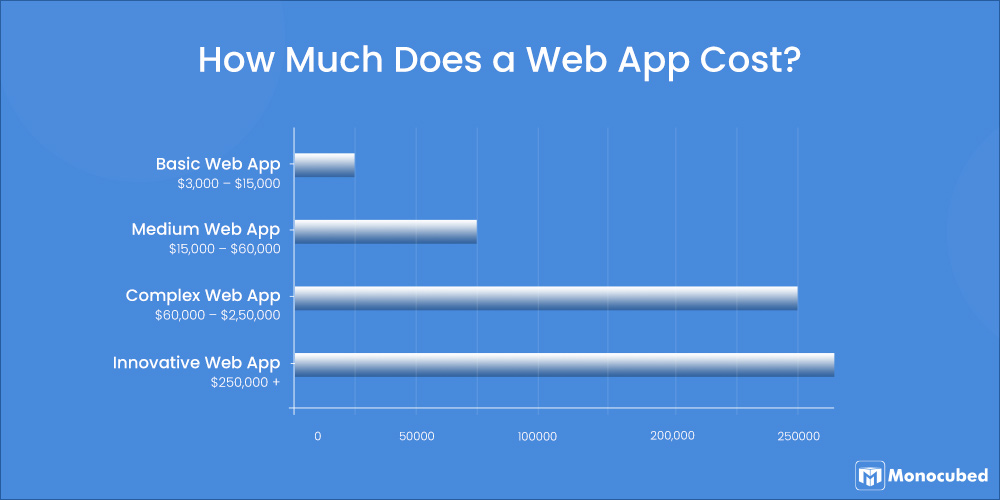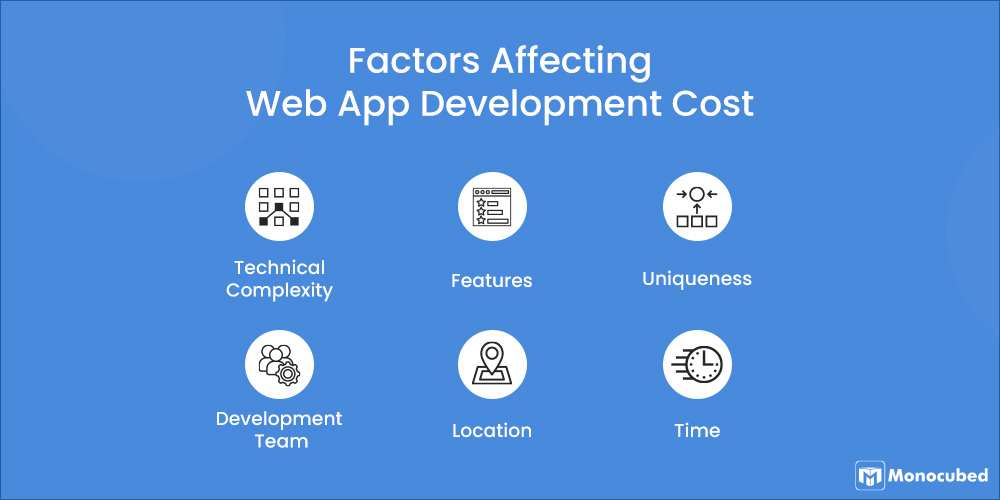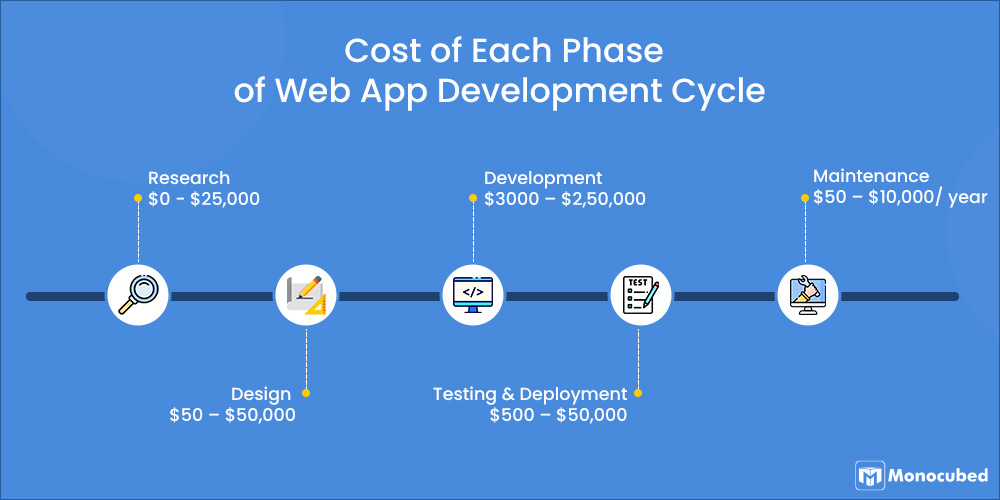Have an innovative web app but wondering how much it will cost?
Want to know how much does it cost to build a web application?
To clear your doubts about the cost of web application development, we have written a one-stop guide for web app development cost. From the average costs of different kinds of web apps to the factors that affect the total cost, you will find all the answers here.
By the end of this blog, you will know the web based application development cost estimation process. You will be able to calculate the cost of developing a web application on your own. We also give tips on how you can cut down costs if you go over budget.
Table of Content
How Much Does a Web App Cost?

Generally, web application development cost depends on the complexity of the app and how much time it will take to develop.
To illustrate-
- Basic apps with minimum functionalities are termed simple web apps
- Apps with interactive content and multiple web pages are medium or professional web apps
- Advanced apps with complex functions and high web traffic come under complex apps
- Finally, unique ideas and completely custom web applications are termed innovative web apps
We will explain in detail how to decide which category your app comes under. But first, let’s find out how much each of these types of web apps will cost.
| Simple Web App | Medium Web App | Complex Web App | Innovative Web App | |
|---|---|---|---|---|
| Approx Cost (in US) | $3,000 – $15,000 | $15,000 – $60,000 | $60,000 – $2,50,000 | $250,000 + |
| Time | 3-6 weeks | 6-18 weeks | 18-25 weeks | +6 months |
| Features |
|
|
|
|
| Examples |
|
|
|
|
Want to Know Custom Web Application Development Cost?
Let’s talk. Discuss your idea with us and get a personalized quote for developing your web app idea.
Factors That Affect Web Application Cost

Before we get a detailed estimate of your web application development costs, it is important to understand what are the different factors that influence the overall cost. Here are 6 key factors that affect the web development cost.
Technical Complexity
The more complex your app is, the more time and expertise it takes to develop and thus costs high.
The complexity of your web application is extremely important in defining the average web app development cost.
There are mainly 3 categories of web app complexity –
Simple Web App
Simple web applications, as the name suggests, are simple to develop and use. They have static information with basic functionality and require minimal coding. Any web developer with knowledge of HTML and CSS can effectively make such web apps.
Most of the development includes drag and drop elements, using preset themes and templates. A user will just be able to scroll and read the website. There are very few interactive elements like contact forms, or graphics and animations.
What are some examples of simple web apps?
Simple landing web apps, portfolio web apps for creative professionals, small online catalogues, HTML web games, simple single-page applications, all come under simple web apps.
Many MVPs (Minimum Viable Product) are also simple apps. With MVP development, startups and enterprises can test the web app idea with a small and basic app before committing to it. But for unique ideas that require implementing innovative functionalities, even the MVP can be a medium or complex web app.
Medium Web App
Medium web apps are interactive with users but still contain generic designs. A medium web app requires a higher level of coding as it contains more complex and dynamic elements.
Although there are a lot of reused themes and predefined template layouts in medium web apps, it also contains dynamic content like website pop-ups, contact forms, animations while scrolling or clicking, user log in and personalized content for each user.
Such web apps require more experienced web developers with a strong knowledge of JavaScript and its libraries and frameworks, along with HTML and CSS. Additionally, it is also necessary to maintain a database and include security measures on the web app if you include user logins and accounts.
You can also integrate third-party apps, for example, a PayPal payment gateway for online transactions or Google Maps for locating the nearest branch of your company.
What are some examples of web apps with medium complexity?
There are many examples of medium web apps today. From simple E-commerce web applications to online games, web portals and web applications for small companies.
Complex Web App
A complex web app is huge, handling hundreds of users and providing multiple services. Each complex web app is custom-made to meet the client’s requirements.
As you can guess, these custom solutions require a long time to build and are expensive. To ensure that the web app functions properly, each element of the app has to be coded from scratch. Meaning thousands of code lines.
What are some examples of complex web apps?
Enterprise-level web apps for managing employees, resources, and clients are one of the best examples of complex web apps. E-commerce stores like Shopify or Amazon with millions of products, complex single-page applications such as Gmail and Netflix, progressive web apps like Twitter and Uber are all complex web apps.
These applications need to maintain a large database, handle high web traffic, and be secure. Many times it also needs to integrate with existing systems and apps. All these requirements require a large development team with web app developers, web designers, UI-UX developers, and a quality assurance team.
How to decide the complexity of my app?
Check the following features to decide what category is your web app –
- Dynamic content – Dynamic content changes if a user clicks or refreshes something. (eg- clicking the like button on your left will increase the number of likes of this blog)
- User accounts – Can your user log in? Are there different types of users according to payment?
- Database – Do you need to save data in your app or is it just content displayed?
- Security- What kind of security does your app require? Check the guidelines and laws your app needs to follow.
- Third-party integrations – Do you need to incorporate third-party apps like email services or payment portals or a social media login?
- Innovation – How many unique features are there in your web app? How many features have to be custom-made?
After you have all the answers, check the table and see which category does your app fall in –
Features Simple Web App Medium Web App Complex Web App Dynamic content User account Third-party integrations Database Innovation Security 3D Animation AI-ML Integration Functionalities Required
The more features you add, the higher the web application development costs go.
Functionalities and features define what your web app is and how it functions. The purpose of your app defines the functionalities, which in turn decides the cost to build a web app.
Some questions to ask yourself when deciding the features of your app-
Do you want the bare minimum features in your app?
Want to have advanced features like an AI digital assistant or a chatbot for customer service?Let’s take a food delivery app for example. The bare minimum features would be showing restaurants, finding free delivery men nearby, and storing contact information.
But to make your app stand out, the app’s functionality has to be upgraded. You need additional features like online payment support, filtering options for restaurants such as cuisine, distance or cost, a map for tracking the delivery man, and so much more.
Each of the basic features and the additional features you add increases the total cost of web development.
But all of this is for backend development. Let’s talk about another important aspect – the frontend or the user interface (UI) of your application.
The more complex and unique you want your UI to be, the more it is going to cost to develop. Apart from the design, it is also important to consider the platform.
Do you want users to access the web app on a PC and laptop? Or do you expect mobile users and tablet users? If yes, you have to develop a cross-platform web app with a responsive design. Which will increase the web application development cost.Innovation vs Standard
As the uniqueness of your app increases, more expertise is required, and the web app development cost increases.
Most times developers use pre-written pieces of code in their web apps. It may be existing templates, libraries, functions, and classes or open-source application codes.
Continuing the food delivery app example, the web developer will not write from scratch every variable and function for the app. Using templates for UI design with changes in a few properties, or using Embed Google reviews API for a ‘leave a food review’ feature on the app.
When you are developing a standard app or a mass-produced app, the cost of development is considerably less. The software developers already have code they can reuse or at least have a reference to base your web application on.
The more unique the idea you bring to the table, the higher the cost to make a web application. Simply because you will require experienced web app developers who can implement your innovative solutions and it will take up more time.
Development Team
The number of members in your development team defines how much the cost of development is.
The project complexity and web application quality will help you decide how many members you need for development.
There are three ways to build web app –
- Hire in-house team
- Hire freelancers
- Hire web app development companies
This table explains the advantages and disadvantages of each of these methods for web application development.
Factors Freelancers In-house Team Web App Development Company When To Use - Small Projects
- Web app update and maintenance
- Adding 2-3 new features
- Budget constraints
- Time constraints
- When you have multiple projects
- No time constraints
- Highest quality
- Complete control over project
- Custom web application
- Support throughout development process
- Highest quality
- Budget constraints
- Strict deadlines
- Idea Validation
Affordable Reliable Portfolio of past work Specific Expertise Quality Assurance Project Management Low time to market Market Research On-time delivery The table will help you decide which model is better suited for your web project. It is now important to choose your web application team. How many developers will you need? Do you need a testing engineer or a business analyst?
Have a Web App Idea? Confused Where to Start?
Get free validation for your idea, free advice from experts and a free quote for development. All you need to do is talk to us.
Let’s look at all the different professionals that are involved in web app development.
- Business Analyst: For researching and analyzing the market and fixing the features of the web application
- Frontend Developer: For developing the UI of the website
- Backend Developer: For developing the app logic
- Database Engineer: For creating, integrating and handling the database
- Web Designer: For designing the web pages – logos, banners and other graphics
- QA or Test Engineer: For testing and ensuring the app is error-free
- Project Manager: For managing the whole development process
- Copywriter: For writing content to be displayed
Depending on your budget and project, you need to hire one or more of these specialties for your web app development team.
Each web development project is different. If you have a background in marketing or management, you don’t require a project manager or a marketing specialist. Similarly, if you already have a team of writers, one of them can handle the content requirements.
If you have a simple web application, you can develop it with only 1-2 web developers and designers or you can hire a full-stack developer. For medium and complex-level apps, you should definitely have a QA engineer and database engineer.
The number of web developers will depend on the different technologies you are using. For example, if you are using JavaScript for both frontend and backend, you need only an experienced JavaScript developer to code the whole app. If you are building a web application with Python and Ruby and JavaScript, you need to hire experienced specialists for each programming language.
Location
The location of the development agency/developers varies the cost of web application development.
Web development is a very labour-intensive job. The cost of web app development is dependent on how many developers you hire and for how long.
The hiring rate for developers varies a lot depending on the country and continent. Even in the US, there is a vast difference in the salaries of web developers for different states. Therefore it is important to pay attention to the location of development to minimize cost.
A web development company in the USA and Canada is relatively expensive, charging $80 – $250/hour. In comparison, choosing a web application development company from countries like Ukraine and India will be cheaper with rates as low as $20- $50/hour.
Outsourcing web app development can be an effective way to reduce costs. But before deciding, consider other factors such as language and cultural barriers and time zone differences.
Timeframe
The deadline you set has to be accurate. Too little or too much development time increases the web application development cost.
It is pretty simple. As you spend more time, you require more resources, and the project cost increases.
But there is another side to it. Giving a very small timeframe to developers can also drastically increase the web application costs.
For instance, developing a fully functional progressive web app (PWA) takes around 4-5 months.
If you set a deadline of 3 months, you will need to hire more developers(probably with more experience) and work them overtime, to get the web application ready.
In contrast, giving 7 months will mean spending more resources and unnecessarily complicating the web application.So progressive web app development cost will over-shoot in either case.
Therefore to get the most cost-effective web solution, you need to set appropriate deadlines.
How Much Does Each Phase of Web App Development Cost?

If you are wondering ‘how much does web development cost’, get a detailed estimate by calculating the cost of each development stage.
The top web development companies of USA and Canada follow 5 main steps in developing web applications or websites. Each phase in the web development lifecycle is essential and requires sufficient time and funds.
| Phase | Development Cost | Development Time | Importance of the Phase |
|---|---|---|---|
| Research and Market Analysis | $0 – $25,000 | 1-5 weeks |
|
| Design | $50 – $50,000 | 1-6 weeks |
|
| Development | $3000 – $2,50,000 | 2-24 weeks |
|
| Testing and Deployment | $500 – $50,000 | 1-4 weeks |
|
| Maintenance | $50 – $10,000/ year | life-long |
|
Total Web App Development Budget: $3,600 –$3,35,000
Total Time: 5 – 40 weeks
(For many enterprises, there can be an unlimited budget with 1+ year development timeline)
Let’s look at each of the phases in a little detail –
Research
Cost: $0 – $25,000
Time: 1 – 5 weeks
It is important to make sure the web app idea is well worth the money and time you are investing. Proper research and analysis of the market are necessary to know your target audience and their needs and expectations.
You can research on your own or hire a market research agency. However, if you are hiring a web development company for web app development, the company will conduct their own research so you don’t have to worry about it.
Design
Cost: $50 – $50,000
Time: 3 – 6 weeks
Working with UI-UX designers and web designers, this phase of the web development lifecycle is designing the look and feel of the website. You create website design and wireframes to understand how each web page will look. Adding new features and wireframes may increase the cost of web design.
It is important to spend enough time on this phase. After all, the design is what the user sees and interacts with. Make sure you are happy with how each element of the page looks before moving to the development stage.
Development
Cost: $5000 – $50,000
Time: Depends on the complexity of the app
The development stage is the crux of the web app development process. All the coding happens in this phase. Web developers will convert the idea and designs into a working application using web development frameworks and tools.
This will be the most lengthy stage with many iterations and re-coding to get each feature working perfectly.
Testing and Deployment
Cost: $500 – $50,000
Time: 1 – 4 weeks
By testing each feature of your web app, you can ensure that your users won’t face any issues while using the web apps.
Testing can catch small errors like an image not loading properly or something major like the database not updating after a user buys a product. Quality assurance is, therefore, necessary as it can find and fix errors that could cost thousands of dollars.
Deployment has some additional web application costs to be considered such as-
- Server hosting ($40 – $200 per year)
- The domain name ($10 – $15 per year)
- Service charges for third-party APIs
- Search engine optimization
Tip – The later you find a bug, the higher it costs to fix it. You can minimize the cost spent in testing and debugging by starting the testing process as early as the design stage.
Maintenance
Cost: $50 – $5000/ year
Time: life-long
To get the estimated cost of a web application development project, don’t forget to factor in the post-release expenses. App maintenance costs can go as high as 20% of your total software development costs per year.
Maintenance is a life-long process. As the web app grows, new errors can arise or the technology can get outdated. Bug fixing, code optimization, adding new features, and scaling all go into web app maintenance.
Estimate Web App Cost Yourself
Now that you know the average web app development costs, and how much each stage of the development lifecycle will cost, let’s find out how much does it cost to build your web app.
Follow these steps to calculate your custom web app development cost –
- Define project scope:
How complex is your web app? How many users will the app support? - Define features:
What are the basic, most important features you need in the app? - Define development team:
How many members in your web development teams? - Decide hiring model:
Hire in-house developers, or freelancers or a web app development company? - Define timeline:
When do you want to deploy your web app? - Define location:
Where do you want to build a website app?
Now that you have your list of requirements ready, you can easily find out the average rate of developing the features and hourly rates of developers in your region. This way you can calculate the average cost of web application development all on your own.
Want A Free Quote for Your Web App?
Discuss your idea with our experts and get a personalized cost estimate for your web app idea. For free.
How to Reduce App Development Costs
Is your development cost going over budget? Follow these steps from the start to reduce your web application cost as much as possible.
Fix the core features from the start
Each new feature you add increases the overall cost of web development.
This doesn’t mean you compromise on the quality of your web platform to save money. But it is important to make sure you clearly define each feature in the planning phase. This will help you avoid an increase in cost later on.
Build a prototype or an MVP
Money gets wasted when in the middle of the project you realize that things aren’t working. Or worse, the final product is not as you envisioned and months-long work is down the drain.
To avoid encountering this incident, start by making a prototype. Especially when working with complex projects, MVP development is very cost-effective.
Prepare a basic prototype with only the important features and minimal functionality. Test it on a focus group. Make changes. This will significantly reduce your development cost and time.
Use third-party integrations
Yes, you might have to pay some fee for using an external API in your web app. But it will save you costs in the long run.
For example, if you want to have a map in your web app, use Google Maps API. Your developers will waste weeks in developing a map feature from scratch and still not work as perfectly as Google Maps.
You can save a lot of money by using third-party services with a minimal fee.
Frequently Asked Questions
How long does it take to develop a web app?
The time required to build a web application depends on the complexity of the app. A simple web app with basic functionalities generally takes 3-6 weeks. A professional web app with payment portals and database integrations can take around 4-12 weeks. Complex web apps such as E-commerce stores and enterprise solutions can take more than 6 months.
Can I build web app for free?
There are free website building sites you can use to develop a web app. But you will still have to pay for hosting the app and getting a domain name. If you are looking for a very simple web app with a standard design and basic functionalities you can develop a free web app. Otherwise, it is better to hire professional developers or a web app development company.
Can I skip web app testing?
No. Many businesses and entrepreneurs tend to skip testing in an attempt to save web development costs. But you can possibly lose thousands of dollars if you don’t test and make your web app error-free.
Conclusion
Web app development cost varies a lot based on the complexity and type of app you are developing. But before starting a project, you can get an estimate of how much the web app costs.
We have also given some tips to avoid going over budget when developing.
Have a web app idea?
Contact Monocubed for getting affordable web app development services. Our developers are experienced in building cost-effective, custom web applications.
 By Jeel Patel
By Jeel Patel



